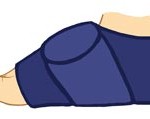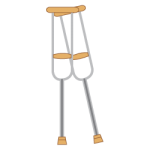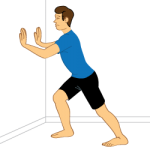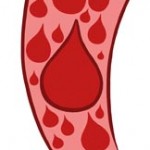The symptoms of foot and ankle tendonitis will vary according to the location, severity and stage of the tendonitis. the most common symptoms are: pain, swelling and stiffness.
Pain
Pain is usually the first sign that there is a problem. There tends to be a sharp or burning pain, usually localized to the area of the tendon at first but as the condition worsens, can spread wider. Pain is usually worse with initial movement, settles down after a minute or so, but then returns as you do more. For example, your first few steps when you get out of bed will really hurt, but the pain will then ease up. But as you are on your feet for longer, the pain will return.
Swelling
It usually takes a while for swelling to develop with the condition. After a few weeks of minor symptoms, you may notice a small lump forming over the tendon, which is often tender to touch. This is most common in Achilles Tendonitis.
Stiffness
The foot and ankle often becomes stiff as a result of ankle tendonitis limiting the amount of pain-free movement.
Treatment
 Ice and compression are always the first steps when dealing with any injury, whether it’s chronic or acute. Inflammation decreases blood flow which increases healing times.
Ice and compression are always the first steps when dealing with any injury, whether it’s chronic or acute. Inflammation decreases blood flow which increases healing times.
 Crutches! With any foot/leg injury people are instructed to use crutches. The same applies for a tendon injury. Staying off your foot will help prevent re-injury and speed up healing times.
Crutches! With any foot/leg injury people are instructed to use crutches. The same applies for a tendon injury. Staying off your foot will help prevent re-injury and speed up healing times.
 Pain killers should only be used when not active. You need to tough it out during the day so your body can tell you when you when you’re hurting yourself. You run the risk of hurting yourself really badly if you take pills to numb the pain, because you won’t know what you’ve done to damage yourself until the pain killers wear off.
Pain killers should only be used when not active. You need to tough it out during the day so your body can tell you when you when you’re hurting yourself. You run the risk of hurting yourself really badly if you take pills to numb the pain, because you won’t know what you’ve done to damage yourself until the pain killers wear off.
 Stretch only if your body tells you it’s okay. Remember that stretching should feel good, and shouldn’t be painful. Pain means that you’re re-injuring yourself and you need to take a step back.
Stretch only if your body tells you it’s okay. Remember that stretching should feel good, and shouldn’t be painful. Pain means that you’re re-injuring yourself and you need to take a step back.
 Heat to stimulate blood flow. Optimal blood flow is imperative for quick healing. Once the inflammation is down, the paths are cleared for nutrient rich blood to invade the injured area, helping speed up recovery times.
Heat to stimulate blood flow. Optimal blood flow is imperative for quick healing. Once the inflammation is down, the paths are cleared for nutrient rich blood to invade the injured area, helping speed up recovery times.
[…] fasciitis is most commonly a repetitive stress injury caused by overuse, but also happens during a sudden shock or excessive downward force to the foot. There can be many […]